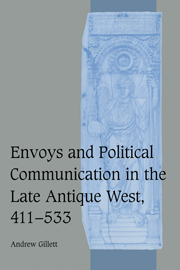Book contents
- Frontmatter
- Contents
- List of tables
- Preface
- List of abbreviations
- Chronological table
- Maps
- 1 EMBASSIES AND POLITICAL COMMUNICATION IN THE POST-IMPERIAL WEST
- 2 THE PROVINCIAL VIEW OF HYDATIUS
- 3 THE HERO AS ENVOY: SIDONIUS APOLLINARIS' PANEGYRIC ON AVITUS
- 4 THE SAINT AS ENVOY: FIFTH- AND SIXTH-CENTURY LATIN BISHOPS' LIVES
- 5 CASSIODORUS AND SENARIUS
- 6 NEGOTIUM AGENDUM
- CONCLUSION
- Appendix I Chronology of Constantius, Vita Germani
- Appendix II Chronology of the life of Epiphanius of Pavia
- Appendix III Senarius' Letters of Appointment: Cassiodorus, Variae IV, 3 and 4
- Appendix IV The text of Senarius' Epitaph
- Note on editions, commentaries, and translations of major sources
- Bibliography
- Index
- Cambridge Studies in Medieval Life and Thought Fourth series
2 - THE PROVINCIAL VIEW OF HYDATIUS
Published online by Cambridge University Press: 12 July 2009
- Frontmatter
- Contents
- List of tables
- Preface
- List of abbreviations
- Chronological table
- Maps
- 1 EMBASSIES AND POLITICAL COMMUNICATION IN THE POST-IMPERIAL WEST
- 2 THE PROVINCIAL VIEW OF HYDATIUS
- 3 THE HERO AS ENVOY: SIDONIUS APOLLINARIS' PANEGYRIC ON AVITUS
- 4 THE SAINT AS ENVOY: FIFTH- AND SIXTH-CENTURY LATIN BISHOPS' LIVES
- 5 CASSIODORUS AND SENARIUS
- 6 NEGOTIUM AGENDUM
- CONCLUSION
- Appendix I Chronology of Constantius, Vita Germani
- Appendix II Chronology of the life of Epiphanius of Pavia
- Appendix III Senarius' Letters of Appointment: Cassiodorus, Variae IV, 3 and 4
- Appendix IV The text of Senarius' Epitaph
- Note on editions, commentaries, and translations of major sources
- Bibliography
- Index
- Cambridge Studies in Medieval Life and Thought Fourth series
Summary
In 467, the Gothic army of Toulouse assembled before its new king Euric. The soldiers, fully armed, were watched by several envoys sent to Euric by Remismund, king of the Sueves in western Spain. Circumstances were tense, for the Sueves and the Goths were on the verge of conflict. As the assembly proceeded, the envoys witnessed a strange sight, which they took to be a portent. The metal blades of the Goths' weapons changed colour; the natural metallic hues drained away, replaced for a time by green, rose-red, saffron-yellow, or black.
This story is recorded by Hydatius of Lemica, a bishop of the western Spanish province of Gallaecia, towards the end of his continuation of the Chronicle of Eusebius and Jerome. It is fitting that the most picturesque incident in Hydatius' Chronicle concerns an embassy, for embassies are an important topic in his record. Late antique chronicles are generically brief, yet Hydatius gives considerable room to accounts of embassies. His presentation of events is unique; no other western narrative source gives such prominence to the actual mechanics of political communication. This apparently minor difference in content deserves to be recognised and underscored, for it is the key to gaining insights into the nature and conduct of fifth-century developments. Extensive patterns of communication, though characteristic of the time, would be barely discernible but for this one source.
- Type
- Chapter
- Information
- Publisher: Cambridge University PressPrint publication year: 2003

